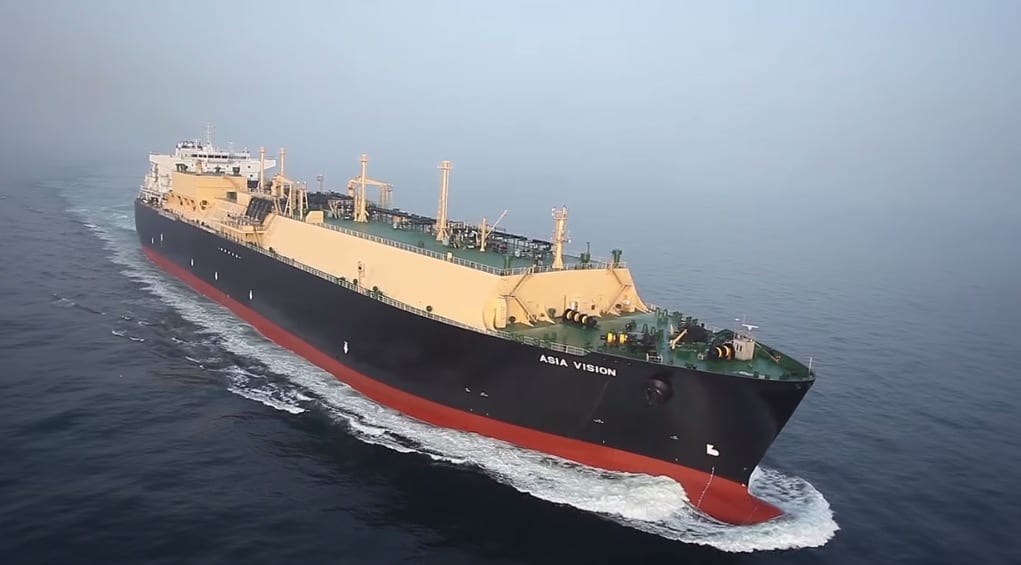Major Cocaine Bust: UK Border Force Seizes Record Shipment at London Gateway
In one of the UK’s largest drug seizures of the past decade, UK Border Force officers have seized cocaine with an estimated street value of £96 million (USD 130 million)...

The 2014-delivered Asia Vision LNG carrier. Photo: Chevron
By Sabrina Valle and Harry R. Weber
(Bloomberg) — Petroleo Brasileiro SA, Brazil’s state-owned energy company, is scheduled to receive the first cargo of shale gas to be shipped from the U.S., according to a person familiar with the deal.
The shipment of liquefied natural gas was agreed to on Monday, said the person who asked not to be identified because the information isn’t public. Cheniere Energy Inc.began loading the first tanker at its Sabine Pass terminal in Louisiana, U.S. Coast Guard spokesman Dustin Williams said in an e-mail Tuesday.
“The biggest buyer of LNG outside of the winter is Brazil first and Argentina second in the Atlantic Basin,” said Ted Michael, an analyst for energy data provider Genscape Inc.“They buy LNG for gas-powered, air-conditioned power.”
Cheniererose 1.2 percent to $30.67 at 1:03 p.m. in New York after earlier gaining as much as 6.5 percent.
America’s first LNG export will hit the water just as global supplies begin to swell, weighing on prices. Other gas-export projects are expected to come under pressure to secure financing and long-term contracts amid the global commodity rout and shifts in demand overseas, Daniel Yergin, vice chairman of the energy consulting group IHS Inc., said in an interview Feb. 17.
Demand is forecast to be higher in South America during the spring, in part due to a drought that has increased Brazil’s dependence on the power-plant fuel. Brazil has increased LNG imports in the past few years after an agreement to buy gas via a pipeline from Bolivia reached its limits.
Petrobras had no immediate comment on the shipment. Cheniere didn’t respond to an e-mail and voicemail. Initial exports will be considered commissioning cargoes as part of the start-up process to ensure the terminal is fully operational. Once that’s complete, Cheniere will need approval from the Federal Energy Regulatory Commission to operate the export terminal commercially.
Tanker Loading
Loading the Asia Vision, the LNG tanker that moored at the Sabine Pass on Feb. 21, may take a few days and the timing of its departure is unclear, Williams said. Genscape, which has cameras pointed at the terminal, said the vessel began unloading ballast water shortly after it arrived and has continued to do so, which is “consistent with taking on more weight from LNG loading onto the ship,” analyst Jason Lord said in an e-mail Tuesday. He estimated it may take closer to 36 hours to load the Asia Vision.
The milestone will pass in the absence of Charif Souki, who was replaced as Cheniere’s chief executive officer in December following disagreements with billionaire activist investor Carl Icahn. Souki wanted to double Sabine Pass’s export capacity over the next eight years, shrugging off weak oil markets and analysts forecasting an oversupply in the global LNG market.
Crude Plunge
This is the first so-called spot cargo from the facility, which began liquefying gas last year. BG Group, a unit of London-based Royal Dutch Shell Plc, will get the first contracted cargo and has agreed to pay about $723 million a year for production capacity once more units come online, Cheniere said in a regulatory filing Feb. 19.
Early movers like Cheniere will enjoy an advantage over rival LNG exporters that are still going through the regulatory process or have yet to make final investment decisions, Yergin said. Developers behind almost two dozen proposed export terminals have applied for regulatory permits, and he projected that only a half-dozen will actually get done.
The plunge in crude oil prices has wiped out most of the discount for U.S. LNG supplies, decreasing their appeal for fuel buyers. Competition for contracts in Europe and Asia, with Chinese companies already committed to receiving more than they need, will also work against U.S. exporters, Yergin said.
‘Symbolically Significant’
Abundant supplies and lower demand have also contributed to a collapse in gas prices for Asia and Europe, which adding transportation costs make it less profitable to ship U.S. cargoes to those markets. The U.K. front-month gas contract slid 38 percent in the past year to trade at 30.01 pence a therm ($4.23 per MMBtu) at 4:08 pm London time Tuesday on ICE Futures Europe. Spot LNG for delivery into northeast Asia declined 28 percent in the past year to $4.95 per MMBtu the week ending Feb. 15, according to assessments published by World Gas Intelligence.
While prices for delivery into South America are typically discrete, Cheniere last year estimated shipping costs to the Americas at $0.50 per MMBtu versus $1 to Europe and $2.50 to Asia. This year, the company put shipping costs to Europe and Asia at $0.50 and $1.50, respectively, without providing costs to ship fuel to the Americas.
Petrobras bought about 80 LNG cargoes last year. It’s expected to purchase another 50 in 2016, according to Porto Alegre-based Gas Energy consultancy.
“It’s symbolically significant,” Marco Tavares, head of Gas Energy, said by phone from Rio de Janeiro, where Petrobras is based. “For Petrobras it’s just another import deal, but from now on the U.S. will be a relevant shale gas exporter.”
© 2016 Bloomberg L.P

Sign up for gCaptain’s newsletter and never miss an update

Subscribe to gCaptain Daily and stay informed with the latest global maritime and offshore news


Stay informed with the latest maritime and offshore news, delivered daily straight to your inbox
Essential news coupled with the finest maritime content sourced from across the globe.
Sign Up